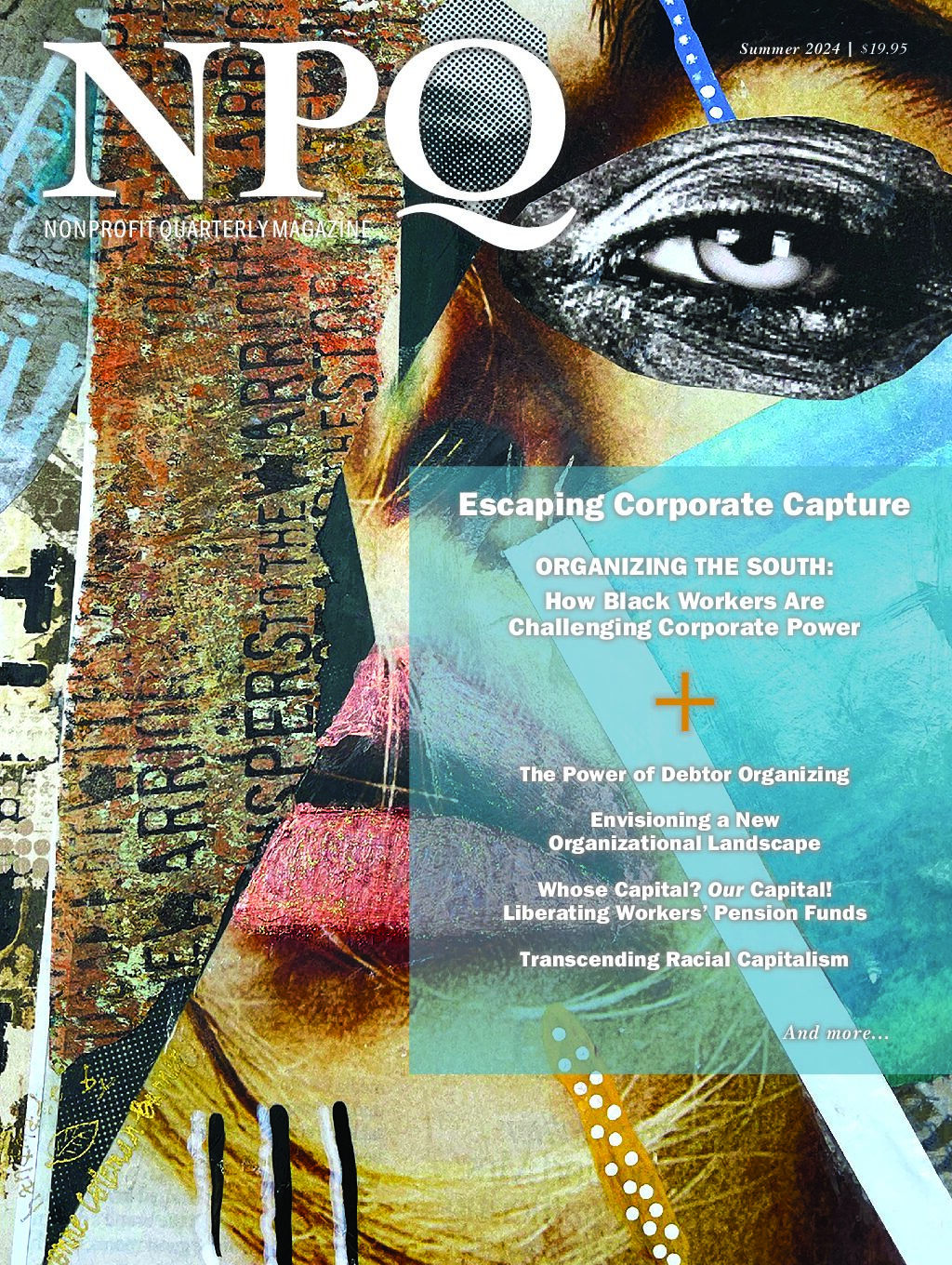
Editors’ note: This piece is from Nonprofit Quarterly Magazine’s spring 2024 issue, “‘Stop Drowning Us, and Stop Making Us Disappear’: A Critical Report on the State of Black Woman Leadership.”
An upsetting number of women of color in nonprofit and philanthropic leadership positions have, over the past two years alone, been fired or forced out of their organizations, or “chosen” to leave, or are confronting tense-to-hostile relationships with their boards around their leadership and stewardship of their organizations.
Numerous reports reflect on the exceptional pressures that women of color face when they are in leadership and the hardships and inequities that they must overcome.1 Their experiences reflect the ways in which some women of color leaders are treated to a “know your place” lesson in terms of power: as soon as a woman of color goes too far and makes a board or staff member feel uncomfortable, she either gets her hand slapped or sees the values misalignment and makes her way out. Boards entrenched in the status quo of dominant culture are having difficulty with acknowledging and adjusting to the evolving realities of what powerful leaders look like. There is a power struggle at play—an old guard having to make way for a new guard—and backlashes are ensuing.
There is a tacit agreement, a balance of power, between every executive and their board: the executive consents to be governed by their board and their board understands that it doesn’t run the organization.
Women of color nonprofit executives are confronting implicit and explicit biases—we are working in a world not designed for us but being shaped by us, and we face more inequities and discrimination than our White colleagues. Being put into positions of power—and sitting in our power, exercising our power, acknowledging our power, leadership, and agency—often puts women of color executives in the crosshairs of extra scrutiny. Consequently, our hold on power is unusually precarious.
This comes into play in a myriad of contexts, such as how funders resource (or fail to resource) women of color in leadership roles2 and the ways in which women of color are hired into leadership roles3—but one that is often overlooked is how power influences how we interact with our boards. The stories shared further on in this article describe power struggles that women of color in nonprofit executive roles experience with respect to their boards. These stories highlight how women of color in leadership roles have to be extra attentive to the ways in which we wield and cede power—and the ways in which our power gets curtailed.
Power Stories
There is a tacit agreement, a balance of power, between every executive and their board: the executive consents to be governed by their board and their board understands that it doesn’t run the organization—rather, it enacts its fiduciary duties to ensure the health of the organization by supporting the organization’s leadership, and it works in partnership with that leader. You may point to your bylaws all you want—but practically speaking, no matter what those bylaws may include, the executive has to agree to (and uphold) the following in service to the health of their organization: share information; implement policies and processes that hold them accountable; and be supervised by their board. An executive has to, in effect, agree to cede some of their power and be governed by a board. And the board, on its end, has to acknowledge that its accountability, transparency, and supervisory capacities require it to be in right relationship with the executive—otherwise, its ability to discharge its duties to ensure that the organization thrives will be compromised.
In fact, we could argue that a board’s power is positional, just as an executive’s is—there is a balance of power, where each is checking the other to ensure fair and equitable outcomes that serve the organization. Yet boards are often unilaterally empowered to hire, supervise, and fire executives; make decisions about an organization’s investments; determine strategy and other future planning; and oversee other big decision points. And they do so without any acknowledgment that they are holders of imperfect information, without any acknowledgment of the need to act in balance with their executive—and further, without the understanding that because they are often distanced from frontline realities, they are therefore beholden to their executives to help them bridge these gaps and succeed in their roles.
Once you add a race and gender lens to this balance of power, those power dynamics become even more fraught. A board might question more, approve requests less often, or expect more power to be ceded, because patriarchy and racism enable those assumptions. It may perceive women of color in leadership as not authoritative enough, and take on more leadership power as a consequence. It may push back when it believes a woman of color leader has exceeded the limits of perceived authority (the “know your place” phenomenon). We still have glass ceilings to break. Women of color in leadership positions need to pay attention to the ways in which we have been acculturated into accepting limits on our power, both from external and internal forces. At every turn, we must ask ourselves the question, How have our society, culture, and environment shaped us and our comfort with leadership, power, and authority?
Women of color executives cannot afford to ignore this subtext underlying our relationships with our boards. As more women of color ascend to leadership roles, one of the strategies we can use to navigate how we choose to hold on to and release power is to pay specific attention to the importance of being strategic in how we engage with our boards. I base this caution on the three stories shared below—stories that are neither anecdotal nor, I fear, isolated incidents but rather larger truths prevalent in the nonprofit sector. The stories are a stark reminder that the power dynamics between a leader and their board can shape not only an individual career but also the trajectory of an entire organization—and further, the future of a field of endeavor. The preservation of our power and leadership and that of generations to come depends on how we sit in our positions of power now and how we shape and are shaped by our interactions with our boards.
If a board does not care about the executive, who will? And if a board uses its power just to control and not to uplift, is it even doing its job?
For the wider nonprofit sector, these stories offer, on the one hand, an invitation to, very simply, interrogate the role and function of a board, recognizing the pivotal role that boards play in shaping organizational culture and success. To ensure a supportive board, board development should not be a passive exercise but rather a proactive strategy for inclusivity, whereby we go beyond token diversity metrics and really ensure that our boards view—indeed, understand—women of color leadership as a driving force behind successful and lasting social progress. On the other hand, these stories can also be a call to action, a resistance banner, to women of color leaders in the nonprofit sector. A call to sit in our power more boldly and to understand that our experiences are shared—and that while we may go through such experiences alone, we are collectively shaping the sector and the future through our pushing of boundaries, our naming of what is happening to us (despite often being helpless to change it on our own), our naming of the dynamics at play. These stories are being told so that women of color feel seen and so that we can realize that we are not alone, that we bear witness to each other, and that we can strategize together on how to support and practice liberatory power.4
Story 1: Start as you mean to go on
This story speaks to how women of color nonprofit leaders must be mindful in their day-to-day engagements with their board around how power gets shared. We often focus on scenarios in which things are more high stakes—leadership transitions, conflicts, large strategic decisions vis-à-vis the vision or growth of an organization. But it is in the day-to-day that strategies are baked, that power gets balanced or goes out of balance, and that we set the tone and culture of our board–executive relationships.
In this case, an executive stepped into an organization in which the board was very much a working board (a board that gets involved in an organization’s day-to-day activities, as opposed to a purely governance or fundraising board). She propelled the organization to continued growth in terms of both size and infrastructure, but she was not supported by her board: they routinely second-guessed her decisions; they operated as if they did not trust her expertise or commitment to the organization; and she was denied the opportunity to make key decisions. It is understandable that a board used to being involved in the everyday business of an organization would find it challenging to let go of that responsibility. So, what was the executive to do? For the duration of her tenure, she tried to negotiate with her board: sharing information to support her decision-making, setting up committees to promote transparency in communication, accommodating as best as she could her board’s desire to be micromanagers. She did not push back, yet she was prohibited from exercising her power—from stewarding the organization as her role required. She was not even permitted to grow the board. She tried to nominate candidates who would be new, independent voices, but she was shut down. The board had set up an autocracy, and one in which the executive was merely the implementer of the board’s decisions. She was able to establish the necessary infrastructure to enable the organization’s growth, and to do fundraising and community organizing, and to develop the programs of the nonprofit; but the decisions that centered around vision, strategy, board growth, and her own compensation and support—areas where there must be a strong relationship, partnership, and sharing of power between board and executive—were held entirely by the board. And they did not care for their executive: they denied her pay raises; they created a hostile environment; they did not set her up for success at all. This board was abusing its power. If a board does not care about the executive, who will? And if a board uses its power just to control and not to uplift, is it even doing its job?
The caution here is for us to start as we mean to go on: how we start off with our boards—how we establish ourselves and how we push back and establish boundaries at the start—sets the tone for how we will be treated throughout. We must demonstrate what sitting in our power looks like. We must be at the helm, establishing values of trust, candor, and care with our boards. We must ensure that we shape board spaces to reflect those values. Certainly, we want our boards to be in leadership as well, but we must not let that happen at the expense of losing our own power. There must be a balance of power and shared values between the two parties.
Story 2: Handle internal conflicts in good time and directly
A visionary, seasoned executive and leader in the field had stewarded a thriving nonprofit to unprecedented strategic focus, growth, and vision. Despite the leader’s stellar reputation and decades-long unblemished management record, a board that was seemingly in alignment with her abandoned her when a challenging situation arose.
This story highlights how fragile the support of our leadership can be and the stark consequences that can occur when conflict resolution takes a back seat to the illusion of organizational stability.
Staff members had been experiencing some interpersonal conflicts. When the situation eventually involved the executive, the board stepped in and took an at best, agnostic, at worst, antagonistic response to the leader. The board did not support her or seek to navigate the internal conflict from a place of trust; instead, it hired outside consultants to handle the “problem.”
These consultants were chosen for their reparative approaches, but they proceeded in a manner that positioned the leader and her team in opposition to each other. The executive brought her concerns to her board chair. She told the chair that she was willing to comply with whatever process the board felt was best for the organization but that she felt the consultants were causing harm. The board was nonresponsive. In the end, despite touting an equitable and reparative process, the board chose to summarily fire the executive. No clear reason was given—there were no findings of fault or wrongdoing. The consultants found that the executive had not managed the internal conflict well, yet they did not implicate her in any harmful action. Possibly, the board found that the executive had some culpability, but it did not communicate this to the executive and neither did it give room in the process for the executive to be heard and her point of view to be respected. The board provided neither feedback nor avenues for remedy, which it should have done. Instead, it abandoned and then fired her. (The shocking decision to disrupt the organization rather than navigate conflict may well have rippling effects in the nonprofit sector—however, much of what transpired is being held in confidence, behind nondisclosure and nondefamation agreements.)
Now, this executive may not have caused the harm, but she could have handled the situation better. She could have been more involved earlier on and managed the concerns more directly. Instead of stepping in with authority right away and making a decision about what needed doing to resolve the situation—which may well have involved firing a staff member—she had begun by directing the staff to try to sort out the conflict themselves before she inserted herself. She also let the board take the helm once the conflict involved her. This is as it should be: if an executive becomes implicated in a conflict, the board is supposed to step in to supervise and do an accountability check. But even then, the executive must be in constant communication with the board—must keep clarifying the situation, must keep ensuring that the narrative does not get used against her. There are certainly bad executives—those who, in order to protect themselves, would seek to silence the voices of their team and to stifle the process. So many teams have suffered at the hands of bad management, of which their board remained ignorant, or an executive perpetuating a hostile work environment, in which the board was complicit. But when you know you’ve not done harm, and you can see the process derailing, as an executive you cannot throw up your hands helplessly. You have the most positional power in this context; and, if you are a seasoned executive, you have the weight of your tenure, experience, and expertise to assist you in navigating how you are perceived better than anyone else in the organization. You have the power, even, to manage yourself—how you show up as a leader in these moments of conflict—and have that define how a conflict gets resolved.
The board…did not have an understanding of the organization’s potential, its place in the ecosystem, and its value. So when the institution faced an existential crisis, the board reverted to what it knew and valued—perceived power.
I share this story because I don’t want to set up women of color leaders as perfect, infallible beings. Sometimes we make mistakes; sometimes we misstep. As we navigate how we lead and how we show up in our power, we will certainly continue to be human. This story highlights how fragile the support of our leadership can be and the stark consequences that can occur when conflict resolution takes a back seat to the illusion of organizational stability. It also highlights something that worries me: if this can happen to a seasoned executive—one with a strong brand and strong appeal, and therefore one who might have been perceived as not being in a position of precarity—what does that mean for the rest of us? This story shows that navigating power dynamics, even for those we think are settled in their power, is precarious for women of color leaders.
Sign up for our free newsletters
Subscribe to NPQ's newsletters to have our top stories delivered directly to your inbox.
By signing up, you agree to our privacy policy and terms of use, and to receive messages from NPQ and our partners.
Story 3: When coleading, don’t hide your light under a bushel
A pair of women of color codirectors had been growing their philanthropic institution together, when some differences began to simmer beneath the surface. A subsequent annual review process only amplified the discord. Faced with codirectors at odds, the board intervened, tasking them with proposing potential new governance structures. The outcome was a testament to organizational misalignment: one codirector sought a solo role, while the other proposed various collaborative designs. The board’s decision to favor the solo vision fractured the staff team, triggering a cascade of departures. Subsequently, the codirector who had become the sole executive left the organization as well, leaving it leaderless.
During their tenure, one of the codirectors had not shown up in her full authority and leadership; the other had—at the expense of her colleague, as it turns out. One was a seasoned, older leader who had started and led multiple organizations. The other was a brilliant, younger leader who had never before led an organization. The more seasoned codirector intentionally took a back seat, because she wanted her counterpart to shine—to not be overshadowed by her expertise. But in doing so, she suppressed the fullest expression of herself: she hid her power. And despite her belief that she had strong, trusting relationships with the members of her board, they did not perceive her as the leader for future growth, notwithstanding her track record. She had incredible vision, she was the source of growth for the organization, and she was a proven leader in the field—a respected social entrepreneur; but she was an older woman, and her counterpart was a younger woman. The board may have been implicitly biased against the seasoned executive because of her age; they were certainly explicitly biased against her style of leadership—in fact, it could be argued that they never understood or saw her real strengths, because she had taken a back seat to her codirector. Meanwhile, the younger codirector was an inexperienced and inadequate manager, but she had a high-level vision for the organization’s future that the board found compelling.
The board was very distanced from the work of the organization. Many of its members were from the corporate sector, and while they loved the mission, they did not have an understanding of the organization’s potential, its place in the ecosystem, and its value. So when the institution faced an existential crisis, the board reverted to what it knew and valued—perceived power. The younger codirector made a power play, and won. The older codirector—who knew everyone, who possessed vision too big to be contained in a building, who had enormous power in the field—found herself being forced out.
In the social justice sphere, the phrase power plays has a negative connotation. Indeed, I have just now implied that the younger executive’s power play was not inclusive. But that’s my own bias, likely due to having been acculturated into being nice over being powerful. There’s so much nuance at play here that this excerpted and redacted account leaves out—but at a minimum, it tells the tale of two forms of leadership and how sometimes we might have to show up in uncomfortable ways. Call it what you like: more powerful, more corporate, more dominant, less inclusive, less collaborative, less accommodating—but we are going to have to lean into all sorts of discomfort to truly sit in our power in these positions.
My friends on boards…were chosen for the good that their professional skills bring to the organization. But make no mistake: when I recruit a friend to serve on my board, I tell them, “Your job is to love me, as well. Love me, and have my back.”
Navigating Board–Executive Power Dynamics: Tactical Tips
Not only are these three scenarios real but I’ve seen replicates played out as well via numerous other narratives floating around the nonprofit ecosystem: the head of a foundation who tried to push her board to take on more progressive stances and was fired at a board meeting; the leader who saw the writing on the wall and left before values misalignment led to outright conflict; the founder of a philanthropic institution who became demonized by her team and not supported by her board. They all left—either by choice or because they were fired. And they are all known, respected, “powerful” women of color in the field. If it can happen to them, what hope do the rest of us have to negotiate how we retain, wield, and cede power when we step into leadership?
This article has focused on demonstrating how power shows up. But let us move from the naming and considering of power to some practical, tactical tips to help us navigate the dynamics of power in an executive–board relationship. It is true that mutual respect, relationship building, honesty, and trust are key factors of a healthy board–executive relationship. As I speak to women of color here specifically, let me be candid: to succeed, we have to think of working with our boards as a chess game, and see five moves ahead—or think of ourselves as puppeteers pulling strings behind the scenes—to make sure that the story unfolds the way we want it to. This also ensures our ongoing safety. And by safety, I mean that given that we have less financial security, less perceived authority, fewer shared bonds that people use as proxies for relationship building—a White man seeing himself in another White man versus a White man seeing himself in an Asian woman, for example, and all other instances of bias hindering the fullest expression of our leadership—we have to do what it takes to ensure that we can inhabit our power and preserve our leadership. How do we do this?
- Review Cyndi Suarez’s book The Power Manual: How to Master Complex Power Dynamics and related articles.5 I encourage everyone to read this Suarez makes the compelling case that “(1) one must constantly refuse powerless identities in interactions and (2) one can build capacity for effective interactions. It is in everyday interactions that one either contributes to unequal power dynamics or interrupts them.”6 She calls this power liberatory power—the ability to create what we want.
- Design and use the board matrix to your Oftentimes, when we step into leadership and seek to grow the board, a current board member will request a matrix—or process—so that they can vet the candidate for what they feel the board needs. This is good practice, but you’ll find that boards that never previously had a matrix suddenly clamor for one once there is BIPOC leadership. This not just infuriating, it is also an exercise of power by the board that lessens our ability to exercise our own leadership power. But we can use that matrix for our own purposes and interrupt that diminishment of our power—and find a way to include our allies within that process and, through that, refute a powerless identity and assert our agency.
I entered into an organization where I had experienced exactly this scenario: the White woman leader before me had never had to withstand the level of scrutiny regarding board development that I now withstood. One board member explicitly stated his concerns that I might bring on only my friends to the board. Well, guess what? It is okay to have your board be populated with people who are your “ride or dies.” Nonprofit leaders can appoint whomever they want to their board in accordance with their organization’s bylaws—and there are legal checks and balances in place to ensure that both executives and their boards are compliant. It is why we have auditors and public filings: to promote accountability. It feels pretty bold to nominate board members, and that is because it is an exercise of power that we may not yet be accustomed to.
My friends on boards are excellent, brilliant people who contribute enormously to my organization and field. They were chosen for the good that their professional skills bring to the organization. But make no mistake: when I recruit a friend to serve on my board, I tell them, “Your job is to love me, as well. Love me, and have my back against any racist/oppressive nonsense. Definitely hold me accountable. Definitely be a strong check and balance to me. But love me. I am a stranger in a strange land, and I need my people.” I say something to similar effect to other board members—that I need them to be my brain trust, my advisors, my supporters. I would likely name that, as a woman of color leader, I face particular pressures and might need to have different kinds of support and awareness. Key takeaway here? The person growing the board has to be you. Nobody else. It is an exercise of power that we have to practice on an ongoing basis.
When it comes to our relationships with our boards, we are dealing with shared power, with a dynamic of power given and taken in both directions—and we have to get comfortable with stretching into our power so that we can disrupt the moments when our power is being taken away from us.
- Take the time to cultivate relationships with your Do not just walk into board meetings. Take the time to get to know each board member. As we practice exercising liberatory power, we must center relationships and the opportunities to transform inequities in power that occur between boards and executives that relationship building offers. Allyship doesn’t just happen—it must be nurtured. Do not do it at the cost of your other obligations, like caring for your team and fundraising, but also do not ignore the power of a coffee or even a text exchange. You should know everyone on your board, and know about their kids, their jobs, where they’re going on vacation. And they should know that you are a human being, as well. And to my earlier chess analogy: think ahead—every coffee you drink with a board member is an easier decision down the road. Do you want some key investments for your organization? Start networking a year in advance. Is there a key motion to be passed? “Socialize it” with your board in advance. And you shouldn’t just rely on your relationship with your board chair; you have to know your entire board.
- Sit (or stand) in your Women of color in leadership positions sit within a maelstrom of shifting power dynamics. We are taking (and claiming) space from people who have historically held these kinds of positions. Even when we are being seen for our inherent leadership, we are not resourced or supported to thrive. We bring with us our own experiences and backgrounds that shape how we feel about power. We have positional power, yet we are often powerless when we confront the systems and structures that surround us. I daresay we don’t even think of our power as a thing to own and celebrate. We may think in terms of service, or support, but not as power brokers, power holders, power wielders. That said, power in and of itself is not bad, but it must be responsibly exercised. Too many cautionary tales of the despotic leader have curtailed our exploration of what it might look and feel like if we were free to exercise our authority. We are swinging the pendulum away from a place where we weren’t afforded power, and we must be mindful that we don’t swing it too far in the other direction.
Conceptualizing power as liberatory power may help us to engage in this journey from a thoughtful place, but regardless of how we conceptualize it, power is complicated. When it comes to our relationships with our boards, we are dealing with shared power, with a dynamic of power given and taken in both directions—and we have to get comfortable with stretching into our power so that we can disrupt the moments when our power is being taken away from us. At the start of this article, I posited that there is a power balance to be maintained between the executive and board—an agreed-to sharing of power that sets both parties up for success. What we often see in reality, and as the stories above attest to, are situations where the power is not shared equally and even is used to harm or limit the power of the executive, particularly when an organization is facing conflict.
Accordingly, we should practice exercising our power to ensure that dynamic doesn’t occur, as a strategy to help us hold on to our resilience and agency while we navigate systems and structures not built by us or for us. We are not the problem here. It’s not the fact that we are leaders or that we are powerful that is in question. But when we come up against glass ceilings, brick walls, glass cliffs, and the harsh realities of patriarchy, racism, and other oppressive systems, we need tactics and strategies to help us preserve our leadership and power. Accordingly, on a case-by-case basis, we should reflect on how each interaction with our board presents an opportunity to practice what it feels and looks like to hold on to our authority and power more strongly in our interactions with our boards than we have historically done before. Take each engagement as an opportunity to level-set how we show up in our leadership.
Like every other leader of color, I am trying to figure this out. I love my board. They are wonderful people. We have navigated many difficult situations. I am a deeply relational leader, and I have invested in developing a cohesive board that cares about me. But I must also think of the woman of color leader who comes after me. What protocols, what culture, am I setting up for the leadership to come?
* * *
The tales of leadership betrayals and organizational disconnects described in this article underscore a critical point: the struggle extends beyond the individual experiences recounted here; it reflects a broader narrative woven into the fabric of nonprofit organizations, where the ascent of women of color is often not met with the support and understanding that is both commensurate with their contributions and necessary to their flourishing and survival. The experiences shared by these leaders are not isolated incidents—they echo a pervasive struggle for acknowledgment, support, and fair representation by women of color leaders. To the women of color leaders who face these challenges, know that your experiences are not in vain. They propel a conversation that demands a reevaluation of power dynamics at the highest levels of the sector, a redefinition of allyship, and a reconstruction of the pathways to leadership.
[T]he struggle extends beyond the individual experiences recounted here; it reflects a broader narrative woven into the fabric of nonprofit organizations, where the ascent of women of color is often not met with the support and understanding that is both commensurate with their contributions and necessary to their flourishing and survival.
Postscript
I’m a lawyer, and I had the good fortune and honor to be taught criminal procedure by Paul Butler, legal analyst and professor of law. Professor Butler spent an entire semester talking to us about habeas corpus, pretextual stops, the ways in which the state oversteps, and the limits on state authority over individual rights. We would have left that class ready to challenge any state trooper who pulled us over, quoting the Fourth Amendment left and right. But during his last class, he looked at all of us—but (I know I wasn’t imagining this) I felt his gaze fall more on those of us who were BIPOC—and he said (I paraphrase here): I don’t care what you learned, I don’t care how well you test and know these legal precedents and rules. If you get pulled over, you do what the cop tells you. You do not trot out the Constitution. You do not challenge their authority. Because you are one person being pulled over on the side of the road. It can’t be one of us, alone on the side of the road, shifting this paradigm—it has to be all of us. It’s too risky for us to take on this challenge one-on-one. So, if you get into some trouble with your board, lawyer up, sign that NDA, negotiate terms, and get the heck out. But make sure you journal or keep a record of what happened, because you will need to remember—you must protect yourself from being gaslighted. Then perhaps you might anonymize and contextualize your experience within a larger whole, so that you can get your story out there and ensure that your experiences are not silenced in the world. We have to use what tactics we can use, safely, to make sure folks know that many of us are harmed by a system not built by or for us, but that when we come together, we can move mountains.
I have been sitting with what happened to Claudine Gay. Regardless of critiques of how she could have done better at the Congressional hearings and in the face of the machinations that led to her resignation, what I saw was not just some of what I have written about in this article but also worse: her experiences, and the way that she was scrutinized, was a shot across the bow to every other Black woman leader to not be bold, not push back, be more cautious. This is even more devastating, and almost more harmful in the long term, because representation matters—but it’s not just the image of a Black woman’s face that inspires so many others, it is what she stands for, what her vision is, what her voice and vision represent. And it’s what many women of color leaders experience: we often hit against this invisible line that we can’t cross—we’re allowed to lead until we make the dominant culture uncomfortable or until we hit a line where we need to “know our place.” We have to maintain inspiration, maintain courage, and preserve our leadership—leadership that is the fullest expression of our power and our vision and our brilliance. We may make decisions to survive, to get out of situations that are simply untenable for our values, morals, and health, but our spirit inside cannot be vanquished. Let us keep working together, talking to each other, and supporting each other as we navigate to change this world. I commend NPQ for doing this kind of work. I look forward to the revolution.
Notes
- Frances Kunreuther and Sean Thomas-Breitfeld, Nonprofit Executives and the Racial Leadership Gap: A Race to Lead Brief (New York: Race to Lead, Building Movement Project, 2019); and Michelle Flores and Elena Conte, Brilliant Transformations: Toward Full Flourishing in BIPOC Leadership Transitions (New York: Robert Sterling Clark Foundation, 2023).
- Numerous articles name the racial gap in philanthropic giving, and this is even more exacerbated with respect to women of color nonprofit See Frances Kunreuther and Sean Thomas-Breitfeld, Trading Glass Ceilings for Glass Cliffs: A Race to Lead Report on Nonprofit Executives of Color (New York: Race to Lead, Building Movement Project, 2022); and Cheryl Dorsey et al., “Overcoming the Racial Bias in Philanthropic Funding,” Stanford Social Innovation Review, May 4, 2020, ssir.org/articles/entry/overcoming_the_racial_bias_in_philanthropic_funding. See also “Racial Equity In Philanthropy—Collected Resources: Closing the Funding Gap,” The Bridgespan Group, accessed February 7, 2024, www.bridgespan.org/insights/racial-equity-in-philanthropy, for a wealth of articles naming racial disparities in funding people of color generally, but with specific reference to women of color.
- See Building Movement Project, Making (or Taking) Space: Initial Themes on Nonprofit Transitions from White to BIPOC Leaders (New York: Robert Sterling Clark Foundation, 2021).
- Cyndi Suarez, “Effective Interactions: Supremacist Power and Liberatory Power,” NPQ, November 28, 2018, nonprofitquarterly.org/effective-interactions-supremacist-power-and-liberatory-power/.
- Cyndi Suarez, The Power Manual: How to Master Complex Power Dynamics (Gabriola Island, BC: New Society Publishers, 2018); and see for example Cyndi Suarez, “Introduction to Power,” NPQ, June 7, 2022, nonprofitquarterly.org/introduction-to-power/ Cyndi Suarez, “Experiments in Liberatory Leadership,” NPQ, June 7, 2022, nonprofitquarterly.org/experiments-in-liberatory-leadership/; and Cyndi Suarez, “Forms: A New Theory of Power,” NPQ, March 18, 2021, nonprofitquarterly.org/forms-a-new-theory-of-power/.
- Suarez, The Power Manual, 13.













